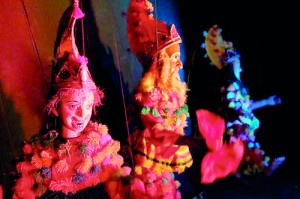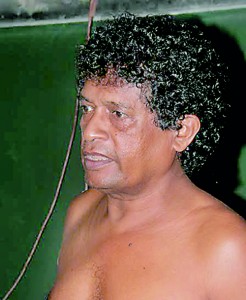The show is over, there’s some applause…
The best kind of art seems to be the bittersweet, something that ignites the senses but burdens the heart. On Sunday, June 8, the University of Peradeniya DRAMSOC presented the Ambalangoda Sri Anura Puppet Society at the E. O. E. Pereira theatre to a small but appreciative audience. The tale of Dikthala and Kalagola was brought to life in a colourful splendour of puppetry, but the real tale told, was that of a dying art.
A puppet show is a rare thing, and so, to rate a performance on any scale becomes a hard matter. The play was rich in sounds and sights, and its execution seemed effortless. But admittedly one needs a sense of cultural awareness to be able to sit through a show of this sort. The tale of Dikthala and Kalagola is well worn, and even with some jokes and dances thrown in for good measure, it can’t compete with today’s action-packed movies and glittering stage-performances. There seems to be, sadly, no relevance of the artists’ creation, to the life of the witnessing audience.
The performance is so old that troupe leader Nalin Gamvary claims that he has in fact been performing this particular play for nearly 50 years. The fact becomes evident as one watches his performance from behind the screen.
Gamvary leans over the back wall of the puppet stage, flicking the strings that control Kalagola with effortless dexterity. He does not even look at his puppet to know what the audience sees. Instead, he turns to K. Gurlimala, also leaning on the back wall and holding Dikthala’s strings.
“Sundari?” he smiles, his voice in a slightly exaggerated lilt.
“Hmm..?” she nods back, eyes closed, thoughtful.
The mics hanging in front of them are picking up every word and breath and amplifying it to the audience beyond the screen, but they are oblivious. They are lovers, like the puppets they hold lightly in their fingers, leaning against a bridge, contemplating how they

Puppet master Nalin Gamvary (
should get to the other side. There seem to be no scripted lines, no choreographed moves, only the intuitive and familiar exchange between a man and his wife.
When the scene moves to the court of the Mahoshada Panditha and Kalagola is taken off the stage, Gamvary hangs his puppet on the rigging behind the puppet stage, and takes his seat behind the harmonium, next to his colleague on his Tabla. Gamvary sings some, then speaks some, and in between lines, coolly drinks water out of a glass bottle. The others move around, speaking lines into mics hanging off the rigging as they manoeuvre puppets or handle props, singing as they pull ropes to drop or raise curtains. Kalagola takes the stage again, complaining of mosquitoes in the darkness of the room the panditha has sent him off to. Puppet master Gamvary has just been slapping some off his bare chest too.
Nalin Gamvary has lived the life, learnt the ropes in childhood from his father and grandfather, and performed on stages across the globe. His life is the stage, and he loves the art, but he doesn’t have enough hope left in it to learn, adapt and relate to his audience.
“Nobody cares anymore,” he shrugs, as he waits for the epilogue to conclude. “I have children, they are still in school, but I will not encourage them to do this.” The Gamvary family has been practising the art of puppetry over the last three generations, both Nalin’s father Lawneris and his grandfather Gamvary Podi Sirina guru being famous for their craft. But Nalin, father of four, feels that now it is time to get over that pride. “It would be foolishness to continue doing this. It is not appreciated anymore.”
The show is over. There is some applause.
The artistes immediately begin taking the costumes off the puppets and packing them quickly but carefully into wooden crates. By the time they start pulling the rigging down, the audience is on the stage, examining the mechanisms of the puppet theatre. The illusion has been shattered; the audience will satiate its curiosity and go home.
After a few hours, the puppets, costumes, rigging and artists will all be packed into the lorry, heading back, in the wee hours of the morning, 200 kilometres home to Ambalangoda. An old art form brought to life an old tale that evening. But nobody even took a bow.
Pix by Ashwin Dominique Jayalath


